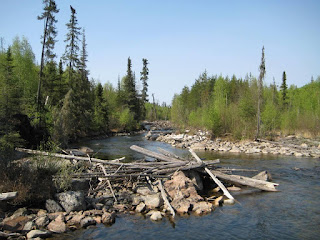I can typically take enough grub for three months. All grocery supplies are off-the-shelf items.
I drink hot water alone with supper, and cold or hot water for other meals. Water is sterilized by boiling for one minute or by a filtration system. The latter removes bacteria and parasites (but not viruses).
Breakfast - 5 days:
scotch mint
protein bar 72g (30g protein)
seed mixture 1/4c (hemp hulled, chia, buckwheat toasted, pumpkin hulled roasted salted)
vitamins
Breakfast - 2 days:
scotch mint
1/2 hot cinnamon bannock (See below.)
grated Parmesan cheese 1/4c
real bacon crumbled 1/4c
vitamins
Lunch - 5 days:
scotch mint
1/2 cold bannock (See below.)
peanut butter smooth 1tbsp
almonds roasted salted 1/4c
Mini Babybel™ cheese 20g (stores well in its wax cover unrefrigerated)
gum
Lunch - 2 days:
scotch mint
1/2 cold cinnamon bannock
almonds roasted salted 1/4c
granola bar Nature Valley™ 35g
Mini Babybel™ cheese 20g
gum
Lunch - 1 day treat:
Skor™ chocolate bar 39g
Supper - daily:
scotch mint
Dairy Milk™ chocolate bar 42g
fresh salad (alder or birch leaves/catkins, or fireweed)
(with sugar 1tbsp, lemon pepper seasoning 1tsp, grated Parmesan cheese 1/4c)
fresh fruit if available 1c
(blueberries, lingonberries, bunchberries, red currants, raspberries, cloudberries, rose hips, Saskatoon berries, pin cherries, crowberries, bilberries)
Supper - 5 days:
macaroni and real cheese 2c (Kraft™ Deluxe Four Cheese or Original Cheddar 400g)
OR both of the following
potato flakes 1c, or bulgur, whole wheat couscous or orzo 2/3c (plus nutritional yeast 1tbsp, chicken soup mix 1tbsp, and butter 2tbsp)
sardines 106g, herring 100g or canned meat 85g portion (corned beef or Holiday™ Luncheon)
Supper - 2 days:
stuffing mix 120g with butter 2tbsp, or oriental noodles 170g
PLUS one of the following
fish coated (cornmeal 1/8c, Montreal steak spice 1tbsp), fried in Crisco™ shortening (1/2lb saved and used over a period of two weeks)
OR
fish diced, boiled and added to the noodles (or to the potato flakes)
OR
small game (roasted over coals, or meat sliced and sautéed in shortening 1tbsp)
Bannock:
2c premixed before the trip (flour 1c, skim milk powder 1/4c, dark toasted wheat germ 2tbsp, white wheat bran 2tbsp, baking powder 2tsp, salt 1/2tsp, sugar 1tsp, Crisco™ shortening 4tbsp)
PLUS 1/4c each of cornmeal and dried currants
Cinnamon bannock:
premixed bannock PLUS 1/4c each of cornmeal, rolled oats and couscous
The dough is split into two layers, between which is added raisins 1/4c, cinnamon 1tbsp, brown sugar 1/4c, butter 3oz (3/8c). A large tart is formed and then baked in Dutch oven.
























































